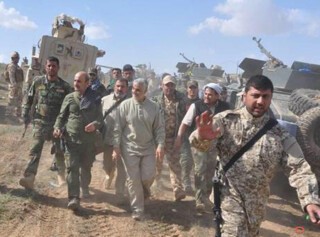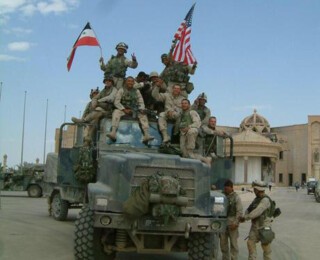Iran’s Deep State
Aaron Bastani
At the beginning of March a photo emerged of Qassem Suleimani, the head of the Quds Force (the extraterritorial element of Iran’s Revolutionary Guard), smiling as he despatched troops into Tikrit, Saddam Hussein’s birthplace and now a front line in the fight against Isis. Ben De Pear, the editor of Channel 4 News, tweeted it alongside a similar photo, of a dozen men in desert fatigues and with smiles as wide as Suleimani’s, making victory signs to the camera. They were US marines in Tikrit in April 2003.
During that brief period of euphoric triumphalism in the White House and Downing Street, you’d have been laughed out of the room for suggesting that Tehran would gain the most from Saddam’s overthrow, and that within 12 years its sphere of influence would extend to four Arab capitals. More likely, the experts would have rejoined, that Iran would itself see regime change, by force if necessary.
Yet as Alireza Zakani, a member of parliament for Tehran, said last September, three Arab capitals – Beirut, Baghdad and Damascus – now ‘belong’ to the Islamic Revolution. The rise of Ansar Allah in recent months (the Zaidi Shia militias fighting in Yemen, often referred to as Houthis) means that Sana’a could be added to the list, though for how long is unclear.
The expansion of the Islamic Republic’s reach can’t be seen in isolation from the Arab Spring. Iran considers the uprisings the continuation of a historical movement it initiated. The former foreign minister Ali Akbar Velayati said in December that Iran supports the ‘rightful struggle’ of Ansar in Yemen, and considers the movement part of the ‘successful materialisation of the Islamic Awakening’ – Tehran’s name for the Arab Spring, which it views as evolving rather than defeated.
In mid-March, Suleimani repeated those sentiments, though he later denied doing so, when he spoke of the way Lebanon, Iraq and even Jordan now yield to Iranian interests. Like Velayati, he repeated that the 2011 uprisings in the Arab world were adopting a more religious tone as events progressed, coming increasingly to resemble Iran’s 1979 revolution.
The Revolutionary Guard, or Sepah, enjoys significant autonomy from both the police and the army, its purpose being to defend the revolutionary ideals of the Islamic Republic rather than the nation’s territorial integrity. Created within days of Khomeini’s return to Iran in February 1979, it resembles in its origins the sans-culottes in the French Revolutionary Army, or the Red Army of 1917.
The organisation now has as many as 150,000 in its ranks, with commercial interests reaching into the construction, energy and petrochemical sectors. It has been claimed that the organisation controls as much as a third of Iran’s economy. At one point half of Mahmoud Ahmedinejad’s cabinet was comprised of former Sepah officers. It provides much of the country’s managerial class, resembling, as Hooman Majd puts it, the French Ecole Nationale d'Administration. Large numbers of men, not only soldiers but bureaucrats, see their life chances tied up with the perpetuation of the regime. If there is a single variable that makes counter-revolution in Iran near inconceivable, it is the Sepah.
So while the Islamic Republic can be understood as a theocratic democracy, with presidential and parliamentary elections and the supreme leader chosen by an elected ‘Assembly of Experts’, it is also a garrison state. Unlike in North Korea or Burma, however, its officer class is comfortable doing business in a range of areas, even if the huge enterprises they run are, for now, blacklisted by the United States and the EU.
Most Western coverage of Iran since 1979 has focused on its clerics or elected politicians, but the Shia Islamic revolution is being exported, or at least expedited, by career soldiers rather than clerics. If Ruhollah Khomeini was the face of the revolution, it is Qassem Suleimani who today carries the torch.

